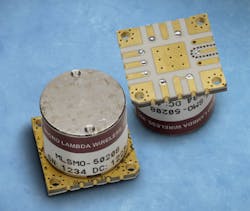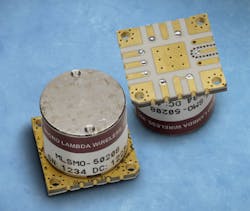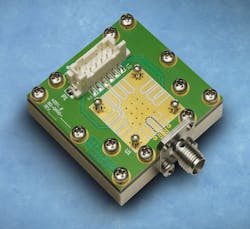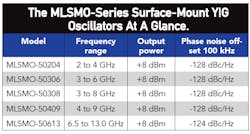Yttrium-iron-garnet (YIG) oscillators are renowned in the RF/microwave frequency industry for their linear tuning and superb spectral purity over wide frequency ranges. But the tradeoff for this performance has traditionally been housing size, with YIG oscillators requiring large, round packages to hold their magnetic components. That has changed dramatically, however, with a new line of surface-mount models from Micro Lambda Wireless.
1. The MLSMO-Series permanent-magnet YIG oscillators are supplied in miniature TO-8 housings measuring just 0.7 x 0.7 x 0.562 in.
The firm’s new MLSMO-Series permanent-magnet YIG-tuned oscillators are supplied in tiny TO-8 surface-mount packages only 0.50 in. high. The oscillators feature silicon-germanium (SiGe) active devices to achieve low-noise output levels. They are available in portions of the frequency range from 2 to 13 GHz with at least +8 dBm output power across their tuning ranges, and with the outstanding spectral purity associated with YIG oscillators, regardless of size.
The MLSMO-Series TO-8 YIG oscillators (Fig. 1) are available in octave and multi-octave frequency tuning ranges, such as the 3-to-6-GHz model MLSMO-50306 and the 3-to-8-GHz model MLSMO-50308. Both provide minimum output power of +8 dBm across their tuning ranges, with minimum harmonics of -15 dBc and spurious content of -70 dBc. The worst-case phase noise for either oscillator is -103 dBc/Hz offset 10 kHz from the carrier and -128 dBc/Hz offset 100 kHz from the carrier. Both YIG oscillators are rated for worst-case frequency drift of ±0 MHz for a standard operating-temperature range of 0 to +65°C. Extended-temperature models for use from -40 to +85°C are also available.
2. A coaxial test fixture is available to simplify setup and tuning of the MLSMO-Series surface-mount YIG oscillators.
At higher frequencies (see table), model MLSMO-50409 tunes from 4.0 to 9.0 GHz while model MLSMO-50613 covers a full octave from 6.5 to 13.0 GHz, both with +8-dBm minimum output power across their tuning ranges. Both exhibit -12 dBc minimum harmonic levels and -70 dBc minimum spurious levels. The lower-frequency model has worst-case phase noise of -103 dBc/Hz offset 10 kHz from the carrier and -128 dBc/Hz offset 100 kHz from the carrier, while the higher-frequency source has minimum phase noise of -124 dBc/Hz offset 10 kHz from the carrier and -98 dBc/Hz offset 100 kHz from the carrier.
All MLSMO-Series TO-8 YIG oscillator models measure 0.7 x 0.7 x 0.562 in. A coaxial test fixture is available with SMA connector to simplify testing these sources (Fig. 2). All surface-mount YIG oscillators have main coil tuning sensitivity of 9.7 MHz/mA and frequency-modulation (FM) coil sensitivity of 300 kHz/mA to control a typical 3-dB FM bandwidth of 1 MHz with ±50-MHz FM deviation. They have typical power requirements of 60 mA at +8 VDC and 15 mA at -5 VDC.
The compact YIG oscillators suffer worst-case output-power variations of 4 dB across their frequency tuning ranges, with typical pulling of 2 MHz into a 12-dB return-loss load and typical pushing of 2 MHz/V for a +8 VDC supply. The MLSMO-Series oscillators are available in RoHS-compliant versions for lead-free designs, and do not require a heater to maintain excellent stability.
Micro Lambda Wireless, Inc., 46515 Landing Parkway, Fremont, CA 94538; (510) 770-9221, FAX: (510) 770-9213, www.microlambdawireless.com.
About the Author
Jack Browne
Technical Contributor
Jack Browne, Technical Contributor, has worked in technical publishing for over 30 years. He managed the content and production of three technical journals while at the American Institute of Physics, including Medical Physics and the Journal of Vacuum Science & Technology. He has been a Publisher and Editor for Penton Media, started the firm’s Wireless Symposium & Exhibition trade show in 1993, and currently serves as Technical Contributor for that company's Microwaves & RF magazine. Browne, who holds a BS in Mathematics from City College of New York and BA degrees in English and Philosophy from Fordham University, is a member of the IEEE.



